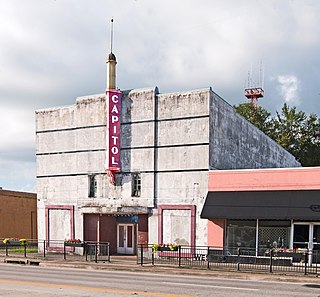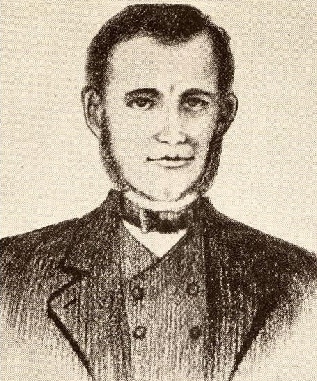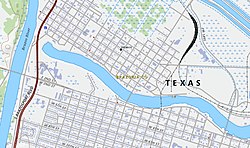
Brazoria County is a county in the U.S. state of Texas. As of the 2020 census, the population of the county was 372,031. The county seat is Angleton.

Angleton is a city in and the county seat of Brazoria County, Texas, United States, within the Houston–The Woodlands–Sugar Land metropolitan area. Angleton lies at the intersection of State Highway 288, State Highway 35, and the Union Pacific Railroad. The population was 19,429 at the 2020 census. Angleton is in the 14th congressional district, and is represented by Republican Congressman Randy Weber.

Brazoria is a city in the U.S. state of Texas, in the Houston–The Woodlands–Sugar Land metropolitan area and Brazoria County. As of the 2020 U.S. Census, the city population was 2,866.

Freeport is a city in Brazoria County, Texas, United States, located on the Gulf of Mexico. According to the 2020 census, the city population was 10,696, down from 12,049 in 2010.

Jones Creek is a village in Brazoria County, Texas, United States. The population was 2,020 at the 2010 census. It is the first location in Texas where Stephen F. Austin settled.

Lake Jackson is a city in Brazoria County, Texas, United States, within the Greater Houston metropolitan area. As of the 2020 census, the city population was 28,177.

For the river in Fort Bend and Brazoria Counties, Texas see: Oyster Creek (Texas).

Quintana is a town in Brazoria County, Texas, United States. Its population was 56 at the 2010 census.

Surfside Beach, also known locally as Surfside, is a city in Brazoria County, Texas, United States, that is situated on Follet's Island by the Gulf of Mexico near the city of Freeport. The population was 482 at the 2010 census. The city has claimed the "Cradle of Texas Liberty" title due to the fact that the Treaty of Velasco which ended hostilities between Texas and Mexico was signed at Fort Velasco, which was located near the city's current City Hall.

West Columbia is a city in Brazoria County in the U.S. state of Texas. The city is centered on the intersection of Texas Highways 35 & 36, 55 miles (89 km) southwest of downtown Houston. The population was 3,644 at the 2020 census.

The Brazos River, called the Río de los Brazos de Dios by early Spanish explorers, is the 11th-longest river in the United States at 1,280 miles (2,060 km) from its headwater source at the head of Blackwater Draw, Roosevelt County, New Mexico to its mouth at the Gulf of Mexico with a 45,000-square-mile (116,000 km2) drainage basin. Being one of Texas' largest rivers, it is sometimes used to mark the boundary between East Texas and West Texas.

The Battle of Velasco, fought June 25-26, 1832, was the first true military conflict between Mexico and Texians in the Texas Revolution, colloquially referred to as the "Boston Harbor of Texas" It began when Texian Militia attacked Fort Velasco, located in what was then Velasco and what is now the city of Surfside Beach. The Mexican commander during the conflict, Domingo de Ugartechea, tried to stop the Texians, under John Austin, from transporting a cannon down the Brazos River to attack the city of Anahuac. The Texian Militia eventually prevailed over the Mexicans. Ugartechea surrendered after a two-day battle, once he realized he would not be receiving reinforcements, and his soldiers had almost run out of ammunition.

The Anahuac disturbances were uprisings of settlers in and around Anahuac, Texas, in 1832 and 1835 which helped to precipitate the Texas Revolution. This eventually led to the territory's secession from Mexico and the founding of the Republic of Texas. Anahuac was located on the east side of the Trinity River near the north shore of Galveston Bay, which placed it astride the trade route between Texas and Louisiana and from there to the rest of the United States. In new attempts to curtail smuggling and enforce customs tariffs from the coastal settlements, Mexico placed a garrison there after 1830. American settlers came into conflict with Mexican military officers, rose up against them, and increased political activity and residents of numerous communities declared support for the federalists, who were revolting against the Mexican Government.

San Luis Pass is a strait of water at the south-western end of Galveston Island off the Texas Gulf Coast of the U.S. state of Texas. It connects the sheltered waters of West Bay to the open Gulf of Mexico. Fishermen and swimmers have been killed in the Pass' treacherous waters, largely due to the aggressive oceanic currents of Gulf Stream, fluctuating tides in marginal sea, marine sediment, and uncertainties of continental margin. The San Luis Pass-Vacek Toll Bridge spans San Luis Pass from Galveston County to Brazoria County.

East Columbia is an Unincorporated community in Brazoria County, Texas, United States. It is located nine miles west from Angleton. It was one of the most important inland ports in Texas. The river port became a vital component in the plantation-based economy that developed along the Brazos River in the 19th century. The community was founded in 1824 by Josiah Hughes Bell. A native of South Carolina, Bell came to Texas with Stephen F. Austin's Old 300 colony in 1821. Bell built a landing of log-lines docks and timbered stops on the Brazos River just below Varner's Creek. Bell laid out the town and called it Marion. Bell sold the townsite to Walter C. White in 1827. By the mid-1800s the town had a population of 800. The arrival of the railroad in the area led to the decline of steamboat traffic which had an adverse effect on the town's fortunes. Storms in 1900, 1909, and 1913 were destructive to the community. When oil was discovered in West Columbia in 1918, merchants abandoned East Columbia. By the 1970s the town's post office had already closed and its population had decreased substantially.
The Brazosport Facts is the largest daily newspaper for Brazoria County, Texas, a part of the Greater Houston area. The newspaper is owned by Southern Newspapers Inc., and began in 1913.

Texas Gulf Coast is an intertidal zone which borders the coastal region of South Texas, Southeast Texas, and the Texas Coastal Bend. The Texas coastal geography boundaries the Gulf of Mexico encompassing a geographical distance relative bearing at 367 miles (591 km) of coastline according to CRS and 3,359 miles (5,406 km) of shoreline according to NOAA.
Port Freeport is the smallest (geographically) deep-water seaport along the U.S Gulf Coast. Located in Freeport, Texas . It has rail access, represents both private and public facilities. It is ranked 10th in the nation for chemicals, 19th in the nation for total tonnage, 26th in the nation for container traffic, handles over 100,000 vehicles per year and has more than 1,000 ships per year. Forbes magazine (2017) ranked Port Freeport as one of the top 10 fastest growing seaports for exports in the U.S.
Fort Velasco was a small circular palisade fort built by a garrison of Mexican soldiers at Velasco, Texas at the present-day location of Surfside Beach on the northeast bank at the mouth of the Brazos River and Texas Gulf Coast. The name also applies to at least three other forts built at almost the same location, one during the Texas Revolution, and two during the Civil War.
Brazosport is an unincorporated community in Brazoria County, Texas, United States. According to the Handbook of Texas, the community had a population of 61,198 in 2000. It is located within the Greater Houston metropolitan area.















